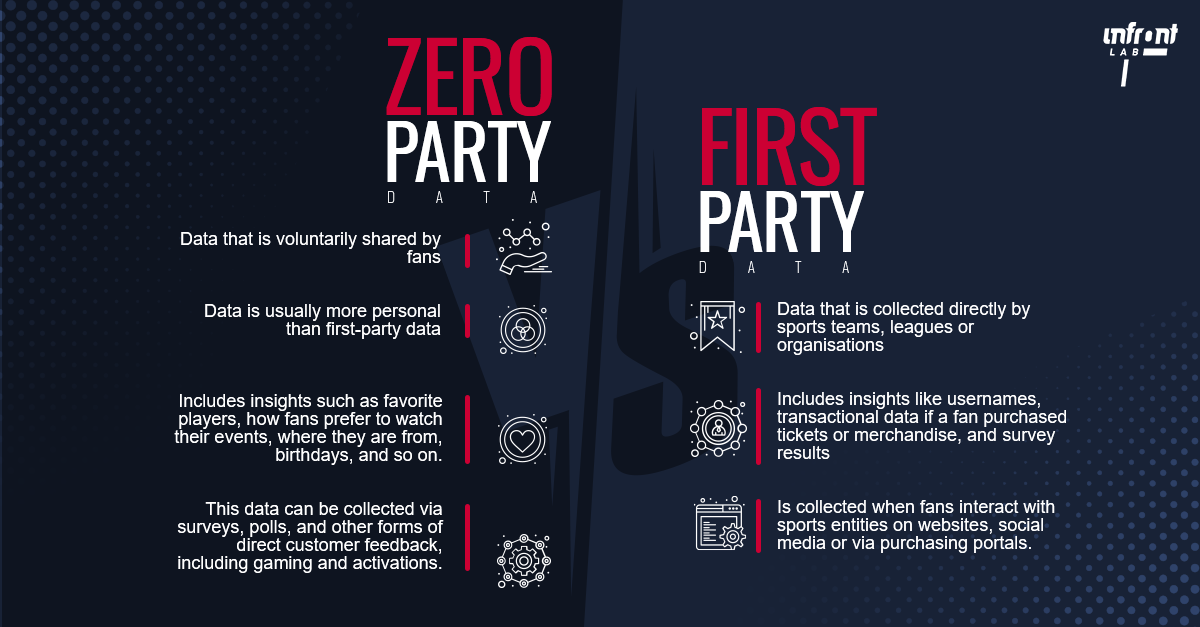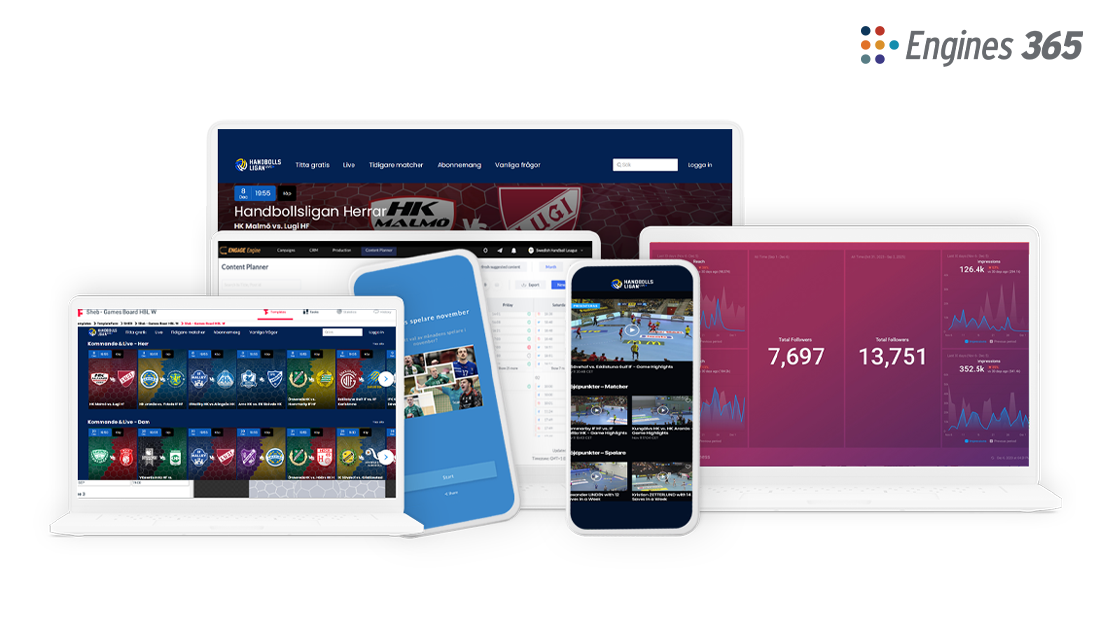Sports technology: It’s impact on rights holders and future potential

Six ways to leverage fan data for better experiences
Unlocking the potential of AI: Four ways machine learning is improving sport
The fan journey: A deep dive into customer experience in the sports industry
Your fans are more willing to provide data than you’d think
Five ways tech will shape the future of sports broadcasting
TABLE OF CONTENTS
- THE RISE AND NEW POTENTIAL OF TECHNOLOGY IN SPORT AND HOW RIGHTSHOLDERS AND BRANDS CAN BENEFIT
- WHAT IS SPORTS TECHNOLOGY?
- THE IMPACT OF SPORTS TECHNOLOGY AT THE VENUE
- THE RISE OF SPORTS TECHNOLOGY IN STORYTELLING
- EXPLORING THE BENEFITS OF SPORTS TECHNOLOGY TO LEARN ABOUT FANS
The rise and new potential of technology in sport and how rightsholders and brands can benefit
Imagine stepping into an arena where every player's move is meticulously charted, each shot or pass is enriched with data, and the boundary between virtual and real is blurring. Welcome to the digital revolution of sports, a journey that started with the humble stopwatch and has now exploded into a world of virtual reality, AI and data analytics.
Historically, the evolution of sports technology has been a tale of consistent innovation. In the early days, a simple stopwatch was a ground-breaking tool, enabling precise time measurements that pushed athletes to better their best. The advent of photo finish technology – surprisingly first used over a century ago at the 1912 Stockholm Olympic Games – transformed how close finishes were judged, while the introduction of the Hawk-Eye system in the 2000s revolutionised decision-making in sports like cricket, tennis and volleyball.
The pace of innovation has accelerated exponentially over the last decade. The introduction of wearable technology began to be widely adopted, providing real-time health and fitness metrics to enhance player performance and safety.
The rise of Over the Top (OTT) platforms has disrupted how sports are consumed, giving birth to a new era of personalised, on-demand sports content. Moreover, social content has played a pivotal role in shaping fan engagement, especially that of younger generations who are watching shorter clips and highlights rather than full games. This has opened a new way to stay connected and informed about the latest exciting moments in sports, especially for cord-cutting fans. In addition, virtual and augmented reality technologies have blurred the lines between the physical and digital, providing immersive experiences that transport fans into the heart of the action.
Today, technology has become an invisible player, profoundly impacting how sports are played, watched, and experienced. It's not just about what happens on the field, court, or track anymore.
This article journeys through the intersections of technology and sports, uncovering the intricacies of player tracking, live storytelling, OTT channels, AI-led content creation, fan data and the shifting terrain of sports marketing and sponsorships in the digital era. From the sidelines to the spotlight, technology is shaping the future of sports in ways we could only dream of a few decades ago.
What is sports technology?
Before we delve deep into the convergence of sports and technology, it's essential to clarify what we mean by "sports technology." At its core, sports technology is the application of advanced tools, devices, software and concepts specifically designed to improve any element of a sport. It's a broad scope which can cover athletic performance, fan engagement and the overall sports experience. It's the merger of sports – the physical, emotional, and team-driven activities that captivate billions worldwide – with technology, the ever-evolving set of tools that expand our capabilities and horizons.
As we proceed, remember that every technological reference, from AI to OTT platforms, stems from this broad definition, encapsulating the dynamic fusion of sports and technology.
The impact of sports technology at the venue
Sports venues, and the work that goes on during a sports event, have long been a place where cutting-edge technology revolutionises the way fans understand and participate in the game. From intricate player data analysis to immersive fan experiences, the stadium, course or track is no longer simply a battleground, but a technological spectacle that transcends physical boundaries.
Player data
The modern era has expanded sports beyond the traditional boundaries of the playing field. Technology has guided sports into a new age where player tracking and data analytics significantly improve player performance and spectator experience.
At the heart of this transformation is the technological advancement of player positional tracking. Companies like Beyond Sports specialise in this domain, using optical cameras and computer vision to record real-time player movements. They collect data of the X and Y coordinates of players on the pitch, creating a comprehensive library of body movements across different sports. Consequently, we gain critical insights into a player's position, speed, and team formation. AI then takes this a step further, predicting the player's next possible move.
The rich pool of player data has enhanced fan experiences through data visualisation. Fans are now treated to inventive displays, such as caricature versions of players or players represented as Ninja Turtles. This playful approach, especially appealing to younger viewers, has made sports broadcasting more immersive and engaging.
The rise of sports technology in storytelling
The narrative realm of sport provides a great platform for technology to not just be the medium but the story-spinner. With emerging OTT channels and AI-powered content, we are on the cusp of a storytelling evolution that intertwines the thrill of the game with the marvels of the digital era.
Live storytelling
The landscape of live sports broadcasting is continually evolving. The pandemic forced the industry to experiment with innovative ways of delivering live sports and engaging fans without a stadium atmosphere. New camera angles are introduced regularly, providing enriched editing experiences for match coverage and highlights.
To maintain revenue, broadcasting more matches, potentially even simultaneously, could be a profitable move for rights holders, broadcasters, and sponsors. Digital platforms, especially online and OTT technology, offer the best potential for this approach.
But today, it's not merely about the match. Fans crave more archive content, exclusive access to athletes, and behind-the-scenes action. With the use of innovative content distribution and production tools, rightsholders can engage fans beyond the live action.
Technologies like machine learning are useful for automated production, making the process faster and more efficient. However, it's essential to note that some sports will adopt this more readily than others.
Unlocking new possibilities with OTT channels
In a digital era characterised by rapidly evolving content consumption patterns, sports industries are leveraging technology and novel content distribution methods to enhance fan engagement and discover new revenue streams. OTT media services lead this shift with their direct-to-consumer platforms that can easily adjust to changing viewer habits.
AI technology plays a pivotal role in this transition. It's used in video technology for tasks from tracking pirated streams to providing sports organisations at all levels with accessible ways to create live and on-demand video experiences. This variety of content across multiple platforms can lead to higher conversion rates, giving viewers precisely what they want.
The control these platforms offer to content owners is significant. They oversee everything from creation, to packaging and sponsorship, and all the way to delivery. This control extends to revenue generation, eliminating the need to share profits with other platforms. In a world where content is diversifying rapidly, this ownership is invaluable.
Reaching younger generations who drift away from traditional broadcasting is a considerable challenge for the sports industry. The success of esports indicates that digital platforms are vital for engaging this audience. For sports organisations to build a sustainable fan base in today's climate, it's crucial that their content can be easily consumed across various devices, especially mobiles, and on different digital platforms.
Automated content creation
AI offers promising avenues for content creation. Technologies like OpenAI's ChatGPT and generative AI can automate and streamline the content creation process, presenting compelling opportunities for sports organisations. For instance, AI can automatically generate summaries of sports events, providing fans with real-time updates. This use of AI significantly reduces content creation time, ensures consistency, and frees up organisations to focus on strategic tasks.
Moreover, the adoption of AI in automated content creation can be extended to social media. This will generate new content and improve fan interaction via chatbots. In turn, it ensures a steady stream of fresh content on social platforms, lessening the workload on human teams and enhancing the overall fan experience.
Exploring the benefits of sports technology to learn about fans
For many rightsholders, fan data remains uncharted territory, but is still viewed as a goldmine of insights powered by sports technology. By harnessing this data, sports organisations can unlock a world where understanding fan preferences isn't guesswork, but a science that reshapes the fan experience and opens new revenue streams.
Understanding sports audience: The power of zero-party data
To tackle pressing challenges, sports organisations are turning to innovative methods to utilise fan data efficiently. They use gaming activations, such as prediction contests and digital memory games, to gather valuable information and build relationships. As part of the engagement, fans knowingly share details about themselves, providing organisations with valuable zero-party data.

This data can be used to create tailored content that resonates with fan behaviour and preferences, leading to higher engagement levels. The most loyal fans can also be identified and leveraged to amplify content reach and engagement.
Beyond enhancing fan experiences, fan data offers new revenue possibilities. Through streamlined content creation and marketing workflows, data-driven strategies can reduce costs. This fan data is also invaluable for sponsors, enabling them to tailor their sponsorships according to fans' preferences and engagement trends.
Sports marketing and sponsorships in the digital era
The world of sports marketing and sponsorships is a dynamic one, constantly changing thanks to technological advancements and data-centric strategies. Brands and rights holders are seeking more effective ways to engage their audience and maximise their return on investment (ROI) from sponsorships.
The evolution of sports sponsorship has turned it into a powerful marketing platform. Brands are now keen on measurable ROI and data-informed insights to evaluate the success of their sponsorships. By utilising primary and secondary data sources, such as cross-media research and social media analytics, brands can assess the visibility and impact of their sponsorship initiatives.
In the digital era of sports marketing, personalisation is key. Understanding your fans and tailoring content and experiences based on their preferences strengthens the bond between fans and sports entities. Whether it's through social media content or streaming services, personalisation enhances fan engagement and boosts the likelihood of long-term loyalty.
By integrating TV advertising with sports sponsorships and embracing sports tech and data-driven marketing, sports entities can thrive in the competitive digital landscape and build meaningful and lasting connections with their fans. As the sports marketing industry advances with new innovations, staying ahead of the curve is essential for success in the digital era.
The sun is setting on the old ways, and the dawn of the digital era in sports is breaking through the horizon, bringing with it new opportunities and challenges. The digital revolution has underscored the importance of technology in shaping the future of sports, redefining not just the game, but also the player, the fan, and the industry at large. As we continue to journey through this digital transformation, the vital role of technology in sports is unequivocal. It's about utilising the power of data, embracing AI, reaching audiences in new ways, and developing meaningful connections that will steer the sports industry into a future of boundless potential.
Indeed, this isn't merely a game changer; it's a new game altogether. Stay tuned, for the best is yet to come.







